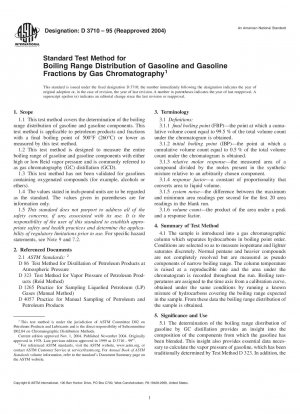ASTM D3710-95(2004)
Standard Test Method for Boiling Range Distribution of Gasoline and Gasoline Fractions by Gas Chromatography
- Standard No.
- ASTM D3710-95(2004)
- Release Date
- 1995
- Published By
- American Society for Testing and Materials (ASTM)
- Status
- Replace By
- ASTM D3710-95(2009)
- Latest
- ASTM D3710-95(2009)
- Scope
The determination of the boiling range distribution of gasoline by GC distillation provides an insight into the composition of the components from which the gasoline has been blended. This insight also provides essential data necessary to calculate the vapor pressure of gasoline, which has been traditionally determined by Test Method D 323
. In addition, the Test Method D 86 distillation curve can be predicted using GCD data. See Annex A1. The GCD method facilitates online controls at the refinery, and its results offer improved means of describing several car performance parameters. These parameters include: (1) car-starting index, (2) vapor-lock index or vapor-liquid ratio, and (3) warm-up index. The car-starting and vapor-lock indexes have been found to be mostly affected by the front end of the Test Method D 86
distillation curve (up to about 200°F (93°C)). The warm-up index is affected by the middle and to a lesser extent by the back end of the Test Method D 86 curve, that is, the temperatures corresponding to the 50 to 90 % off range. Since the boiling range distribution provides fundamental information on composition, an improved expression for the above performance parameters may be worked out, even when the boiling range distribution curve is not smooth. Currently, car performance cannot be assessed accurately under such conditions. 1.1 This test method covers the determination of the boiling range distribution of gasoline and gasoline components. This test method is applicable to petroleum products and fractions with a final boiling point of 500176F (260176C) or lower as measured by this test method.
1.2 This test method is designed to measure the entire boiling range of gasoline and gasoline components with either high or low Reid vapor pressure and is commonly referred to as gas chromatography (GC) distillation (GCD).
1.3 This test method has not been validated for gasolines containing oxygenated compounds (for example, alcohols or ethers).
1.4 The values stated in inch-pound units are to be regarded as the standard. The values given in parentheses are for information only.
1.5 This standard does not purport to address all of the safety concerns, if any, associated with its use. It is the responsibility of the user of this standard to establish appropriate safety and health practices and determine the applicability of regulatory limitations prior to use. For specific hazard statements, see Notes 9, 10, 11, and 15.
ASTM D3710-95(2004) Referenced Document
- ASTM D1265 Standard Practice for Sampling Liquefied Petroleum (LP) Gases (Manual Method)*, 1997-04-19 Update
- ASTM D323 Standard Test Method for Vapor Pressure of Petroleum Products (Reid Method)*, 1999-04-19 Update
- ASTM D4057 Standard Practice for Manual Sampling of Petroleum and Petroleum Products
- ASTM D86 Standard Test Method for Distillation of Petroleum Products*, 1996-03-22 Update
ASTM D3710-95(2004) history
- 1995 ASTM D3710-95(2009) Standard Test Method for Boiling Range Distribution of Gasoline and Gasoline Fractions by Gas Chromatography
- 1995 ASTM D3710-95(2004) Standard Test Method for Boiling Range Distribution of Gasoline and Gasoline Fractions by Gas Chromatography
- 1995 ASTM D3710-95(1999)e1 Standard Test Method for Boiling Range Distribution of Gasoline and Gasoline Fractions by Gas Chromatography
